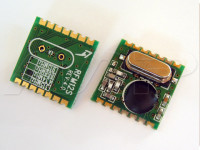RFM12 Library for STM32 written in C

If more power or larger memories are needed, the 32 Bit-MCUs based on ARM cores are a good choice. They are available in the market from many suppliers in different configurations.For his projects, the author has decided for the STM32 family of STMicro.
main.c: This is a test program for the Lib. It is organized a multiple finite state machine, in order to demonstrate the non-blocking mode. It uses an external Interrupt on GPIOA.8. The ISR for this has to be included in your app as well.
- Init the RFM12 by calling InitRFM12 (only once)
- Fill the the buffer Txbu according to the protocol
- Start transmission by RFMPutStart
- Now you can do something else or
- Ask the status of transmission by RFMPutReady
- If this function replies with 3 then put is done and OK
- Init the RFM12 by calling InitRFM12 (only once)
- Start receive by RFMGetStart
- Now you can do something else or
- Ask the status of receive by RFMGetReady
- If this function replies with 3 then get is done and OK
- Take the message out of buffer Rxbu
- InitRFM12
- RFMPutStart
- RFMPutReady
- RFMgetStart
- RFMgetReady



Discussion (0 comments)